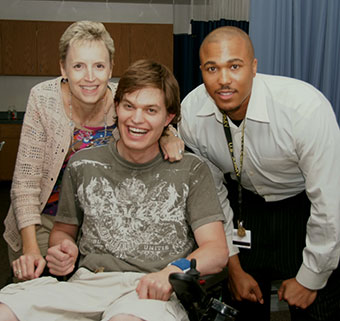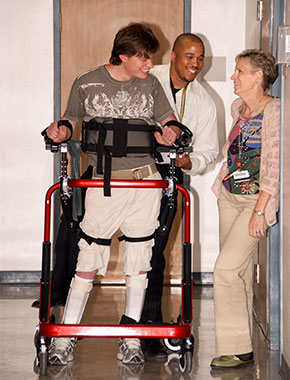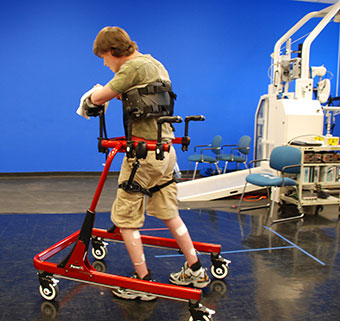Long-term disability is a frequent sequel of traumatic brain injury (TBI) and takes the form of persisting motor impairments that impact walking and autonomous movement. So to improve environmental negotiation and basic care skills, independent gait is an essential therapy goal for TBI patients.
Literature shows that the best time for independent gait recovery occurs within the first few months after injury. But early gait intervention, by necessity, comes second to the other complications and concerns of a healing body, and the window of opportunity for the best possible gait recovery quickly closes.
 Needless to say, there is a growing population of people with chronic TBI and poor gait prognosis and functional outlook. That is why a recent case study in the Journal of Neurologic Physical Therapy is a welcome addition to the limited literature regarding interventions for individuals with chronic TBI.
Needless to say, there is a growing population of people with chronic TBI and poor gait prognosis and functional outlook. That is why a recent case study in the Journal of Neurologic Physical Therapy is a welcome addition to the limited literature regarding interventions for individuals with chronic TBI.
The study centers around a young man, Sean, with chronic TBI resulting from a motor vehicle accident four years earlier. Before coming to the Gait Disorders Clinic at the University of Texas Southwestern Medical Center, Sean had previous therapy interventions including body-weight supported treadmill training, hippotherapy, over-ground walking with a platform walker and aquatic therapy, but he was still dependent for all walking activity and activities of daily living (ADLs).
Motor Learning and Gait Intervention
 So his primary goal on coming to the clinic was to regain the ability to walk independently. His therapist (and author of the study) Karen McCain put together a treatment plan that incorporated the literature-supported interventions of locomotor treadmill training and functional electrical stimulation, but additionally drew heavily on the principles of motor learning – namely salience, intensity, repetition and task specificity.
So his primary goal on coming to the clinic was to regain the ability to walk independently. His therapist (and author of the study) Karen McCain put together a treatment plan that incorporated the literature-supported interventions of locomotor treadmill training and functional electrical stimulation, but additionally drew heavily on the principles of motor learning – namely salience, intensity, repetition and task specificity.
Salience
While it may seem obvious, it is important to recognize that motor learning improves when the intervention has meaning for the patient. Sean wanted to walk, he was motivated and willing to put in extra effort to achieve this goal. His therapists included walking intervention in all 79 treatment sessions. (Sessions were 2x/week with each session lasting 45-60 minutes).
Repetition and Intensity
Because repetition and intensity contribute to neuroplasticity, giving Sean ample opportunities to walk was essential (especially after four years of limited gait recovery). Body-weight support over a treadmill was chosen initially because  of the support, sensory input and maximum repetition afforded by this intervention. Over 32 sessions, Sean advanced significantly in speed and eventually walked without BWS or assistance for leg advancement.
of the support, sensory input and maximum repetition afforded by this intervention. Over 32 sessions, Sean advanced significantly in speed and eventually walked without BWS or assistance for leg advancement.
One week into the rehab, Sean also began walking over-ground, at first using parallel bars. But his most significant improvements in over-ground walking started when he used a Rifton gait trainer. The stability and support of the device gave Sean the opportunity to practice walking, not only in the clinic but at home. He walked in the gait trainer at home from 1-3 hours every day in the early phases of intervention to reinforce and maintain the gains made in the clinic. In the clinic, Sean also walked with a specialized forearm crutch to cue balance and upright stability.
Task-Specificity
Although Sean had previous therapy interventions, he did not achieve significant gains in walking. Perhaps it was because these interventions were not specific to walking (i.e. hippotherapy and biofeedback) resulting in minimal cumulative walking experience. During this study however, the focus was walking—in the clinic, outdoors and at home. A gait trainer better fitted Sean’s needs and efforts at meaningful gait (as opposed to the platform walker) in combination with a heel lift, orthoses and functional electrical stimulation to facilitate more specific walking practice.
Gains in Gait and Functional Improvements
 At the end of 14 months of rehab, Sean was walking 3000 feet in the gait trainer and up to 350 feet with a crutch and minimal assistance. Additionally, his standing balance improved which, in turn, improved his toileting and dressing skills. His baclofen pump was removed and he regained full head control (he could only hold his head up for 10 seconds at initial examination).
At the end of 14 months of rehab, Sean was walking 3000 feet in the gait trainer and up to 350 feet with a crutch and minimal assistance. Additionally, his standing balance improved which, in turn, improved his toileting and dressing skills. His baclofen pump was removed and he regained full head control (he could only hold his head up for 10 seconds at initial examination).
The key differences between this study and others is the length of intervention (over a year) and the focus on motor learning parameters. This may be something to consider for other individuals in the chronic phases of TBI recovery.
Sean Today
Sean continues to improve and is now walking independently at home and in the community with a reverse walker. He no longer uses his power wheelchair and is independent in all ADLs. Dr. McCain’s contribution is a welcome and important addition to a limited body of evidence.
Reference
McCain K, Shearin S. A clinical framework for functional recovery in a person with chronic traumatic brain injury: a case study. JNPT. 2107;41:173-81.
Back to Top** This post was originally published on http://www.rifton.com/adaptive-mobility-blog/blog-posts/2017/july/tbi-gait-rehab-evidence

